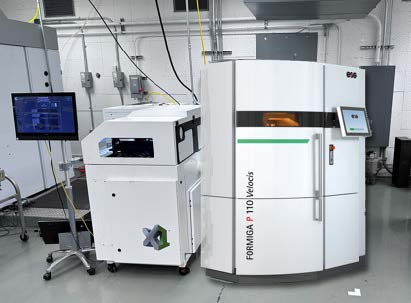


EOS P110 Polymer Laser Sintering Machine used in cold metal fusion printing process
Problem
The Department of Defense (DoD) industrial base continues to adopt advanced manufacturing technologies that enhances the readiness and effectiveness of the United States military. Adoption of additive manufacturing (AM) is creating new opportunities to provide advanced technical solutions to the warfighter. However, material qualification, material cost, and overall process efficiencies are limiting broader implementation of AM. Cold metal fusion can provide a more efficient and cost-effective solution to support the warfighter, but limited testing of this emerging process exists. Further testing is necessary to prove the process and inform the larger DoD industrial base.
Objective
The project objective is to develop and demonstrate a cold metal fusion process through manufacturing and testing three Ti6AI4V material manufacturing builds.
Technical Approach
To investigate and evaluate cold metal fusion, the research team led by The Ohio State University (OSU) Center for Design Manufacturing Excellence (CDME), will perform four separate tasks.
- Task 1 involves commissioning the EOS P110 while concurrently drafting a 10-page technology overview to be submitted at the end of the project. Further, the team will compare the productivity and design criteria to those of similar modalities (Laser Powder Bed Fusion, Directed Energy Disposition, Binder Jet, etc.).
- Task 2 involves creating three manufacturing builds from Ti6AI4V material, verifying machine parameters, and assessing part performance. The first build specimen will be geared toward parameter development and the second build specimen will consist of mechanical test specimens (tensile and fatigue). OSU and Tinker Air Force Base (AFB) REACT Laboratory will collaborate to determine a demonstration component to use as the third test specimen.
- Task 3 will focus on measuring the green and final part densities, conducting tensile testing, and performing basic material characterization to assess the mechanical properties of the produced parts.
- Task 4 involves consolidating all the findings from the previous tasks into a comprehensive final report. The final report will serve as a valuable resource for the DoD and its supply chain, providing them with insights into the feasibility and potential of cold metal fusion technology.
Project Participants
Project Principal

Other Project Participants
- Headmade Materials
- EOS
- Air Force Research Laboratory (AFRL)
- Air Force Sustainment Center
- NCDMM/America Makes
Public Participants
- U.S. Department of Defense
